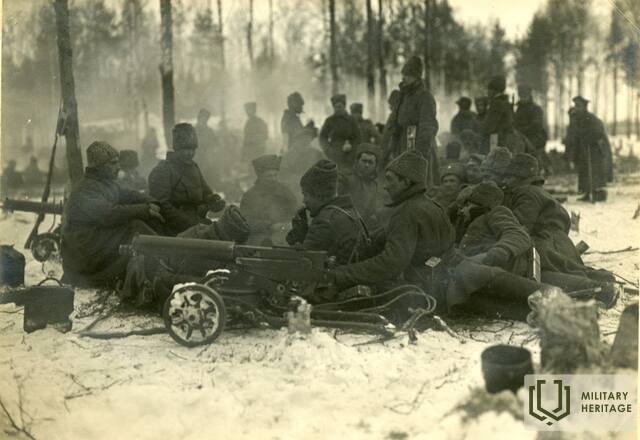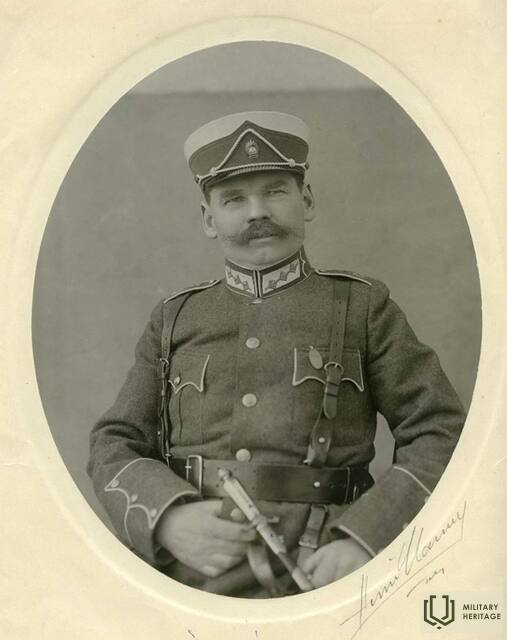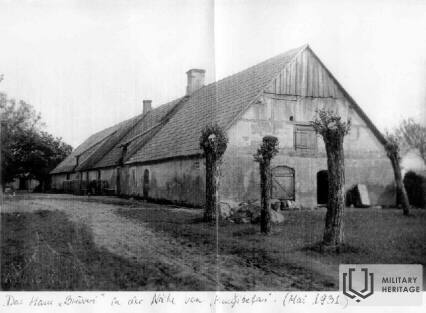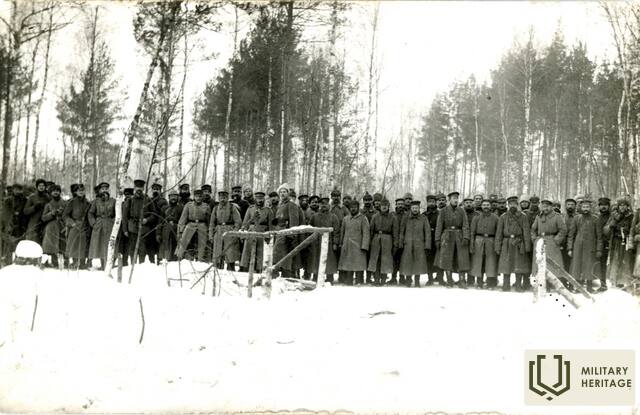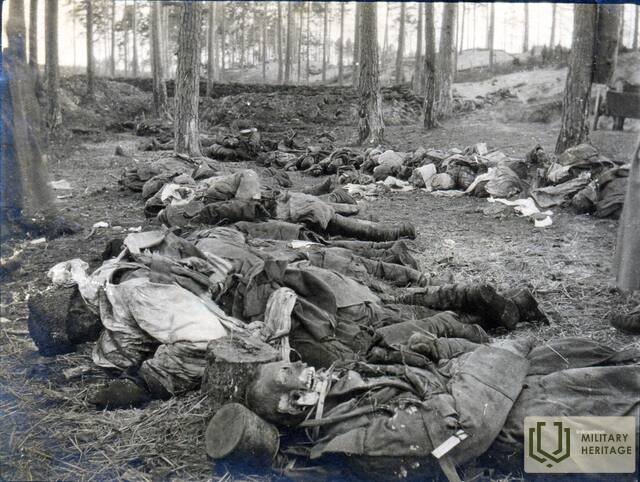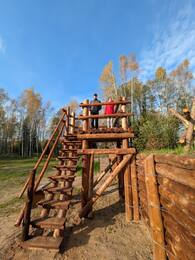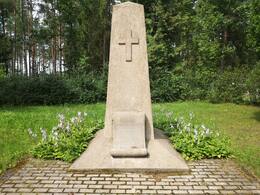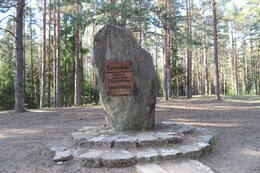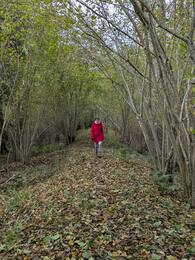A diary entry about the moment when soldiers learn about preparations for the Christmas battles.
The Latvian riflemen and their officers were informed about the beginning of the battle at the last moment. The non-commissioned officer of the 5th Zemgale Latvian Riflemen Regiment, Rūdolfs Ivanovs, described in his diary the last evening before the start of the battle. A short, but vivid and authentic text that shows a very important moment for a soldier – learning about the day of the battle.
“This morning we were told that tomorrow at 5:00 we had to go on the attack. This time all eight Latvian rifle regiments would go on the attack. We began to prepare for our upcoming task. The first task was to put on clean clothes and put all the other unnecessary clothes in our bags. We added the addresses of our hosts to the bags and handed over all our jewelry to the head of the household for storage. We also handed over the bayonet holsters to our husbands, keeping only the rifle with the bare bayonet, the grenade bag, and the gas mask for ourselves. We doubled our usual quota, because we received additional chest cartridge bags full of cartridges. Then the bayonets were sharpened on a brick or stone, but we wrote letters to our hosts about all the things, perhaps writing our last greetings, because we did not know where and under what conditions we would be on the battlefield tomorrow. Among ourselves, among our closest comrades, we trusted each other the other, the addresses of their loved ones: if someone is destined to leave our ranks on the battlefield, then those who survive should notify the families or loved ones of the fallen.
https://www.sargs.lv/lv/pirmais-pasaules-kars/2015-12-08/ziemassvetku-kaujas-latviesu-strelnieku-atminas
Related timeline
Related objects
Christmas Battle Museum
The museum is located in “Mangali” house, Valgunde Rural Territory, Jelgava Municipality, and it is a branch of the Latvian War Museum. It was unveiled in 2005 at the site of the Christmas Battles that occurred during World War I. Unique World War I fortifications still remain at the battle sites. The open-air exhibition of the Christmas Battle Museum reconstructs a section of the fortification system – the trench shelter and part of the first line of German defence – the “German rampart”, which is the only object of this kind in the Baltic states.
The Christmas Battles are one of the best known and most dramatic events of World War I in Latvia. They are an event of special importance in Latvian military and cultural history. Intense fighting took place for six days, leading to heavy casualties. The battles are mainly associated with the attack of Latvian Riflemen against the German Army units, which took place in particularly severe and unfavourable winter conditions. This is an unprecedented case of a major combat operation launched without artillery support.
Today, the museum artefacts found at the sites of the battle are on display. The indoor exhibition is open at certain times, while the exhibition of outdoor fortifications is open every day. Tourist routes and nature trails have been created in the surrounding area.
Christmas battles memorial at Antinu Brethren Cemetery
Located in Babīte district, on the side of the road near the former Antiņi house and the old medicine warehouse.
The Antiņi or Tīreļi Soldiers' Cemetery was established during World War I. The area was home to defensive positions of the Russian Empire Army. In 1917, during the Christmas Battles, the headquarters of the 5th Zemgale Latvian Rifle Regiment, a hospital with a medicine warehouse, were located nearby.
In 1917, on the night of January 5-6, under the illumination of eight huge bonfires, 105 fighters of the 5th Semigallian Latvian Rifle Regiment were buried with military honors. They fell in battles against the German army or died of wounds. The burial ceremony was led by the regiment's commander, Jukums Vācietis. In later years, soldiers from other units of the Russian army were also buried in the cemetery. In 1925, a monument by architect Eižens Laube was unveiled in the cemetery, and the territory was landscaped. Information about 3,800 soldiers buried in the cemetery is found in many places, but it should be considered unlikely and unverified.
Ložmetējkalns (Machine Gun Hill) in Tīreļpurvs Bog
Ložmetējkalns is located in Valgunde Rural Territory, Jelgava Municipality, close to the A9 motorway. It is the site of a World War I battle and the only cultural heritage conservation site of national importance in Latvia. Ložmetējkalns is located on Garā Kāpa Dune, which is a part of the Nordeķi-Kalnciems dune ridge. The name originated at a time when it was the site of impregnable fortifications of the German Army, which was defended by heavy machine-gun fire.
The Christmas Battles are one of the best-known and most dramatic events of World War I in the history of Latvia. In 1917, the units of Latvian Riflemen and Siberian riflemen of the Russian Army attacked and took Ložmetējkalns, capturing at least 600 enemy troops and valuable trophies. The riflemen believed that they were the ones who deserved the honour of captors of the highlands.
The area around Ložmetējkalns Hill is home to commemorative marks and other evidence of the battles that took place here. Every year, in January, memorial events are held in the surroundings of Ložmetējkalns to remember the Christmas Battles. Nowadays, Ložmetējkalns has become a symbol and a memorial site dedicated to the heroism of Latvian Riflemen. A 27-metre-high observation tower offers panoramic views of the site of Christmas Battles.
German rampart
A "German Rampart" is a defensive fortification built by the German army and used during the Christmas Battles of 1916. It consists of an earthen rampart reinforced with wooden structures and barbed wire, forming a shield against attack. This type of fortification was common during World War I to strengthen front lines and protect troops.
The "German Wall" can be viewed by following a 7 km long hiking route, which begins at the Mangaļi House - the Christmas Battle Museum. In the vicinity of the museum - in the nearby forests, a natural trail runs along the "German Wall", which is also managed, that is - easily accessible for pedestrians. It should be taken into account that the "German Wall" is an open-air object - there may be a fallen tree, the terrain is uneven. The "German Wall" also extends further north and crosses the Maztīreļa Bog, but in this area it is overgrown and is more suitable for "adventure" and "expedition" seekers, not "Sunday walkers".




